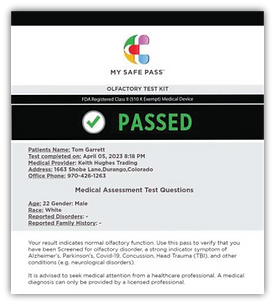
2-minute Test
The Concussion
Game-Changer
Safe. Simple. Science-Driven.

All you need is the MySafePass Test Card and a Cell Phone

Rapid, objective, mobile concussion screening
Fast Results
Under 2 minutes

FDA Registered
Medically validated
Objective Testing
Clear pass/fail outcome
The Challenge: Concussions
1.6 - 3.8 million
Concussions
An estimated 1.6 - 3.8 million sports-related concussions occur annually in the United States.
50 - 60 %
undiagnosed
Missed Assessments
Up to 50-60% of concussions go undiagnosed using traditional assessments
5 X
higher risk
Long-Term Impact
People with undiagnosed concussions face up to 5x higher risk of serious brain injury if returned to play too soon.


The Problem
-
Concussions are prevalent in sports but difficult to diagnose on the sideline, putting athletes at serious risk.
Current Limitations
-
Affected by player adrenaline and motivation to return to play
-
Traditional assessments (eg. SCAT5) are subjective and time-consuming
-
Low sensitivity misses subtle brain injuries
"The 2-minute MSP smell test of olfactory function would be a game-changer for our understanding of repetitive head injuries."
~ ScienceDirect.com
The Solution: MSP Olfactory Concussion Testing
Revolutionary Approach
MySafePass (MSP) delivers an innovative olfactory test that objectively detects concussions by measuring changes in the brain's smell processing pathways.
Proven Science
The olfactory system is directly connected to brain regions vulnerable to concussion damage. When injury occurs, smell processing is immediately affected—often before other symptoms appear.

01
Rapid Assessment
Complete test in UNDER 2 MINUTES, allowing for immediate sideline decisions
02
Objective Results
Clear pass/fail metrics eliminate guesswork and subjective interpretation
03
Medical Credibility
FDA Class II registered medical device with peer-reviewed scientific validation
MySafePass offers what current protocols lack. A fast, objective, and non-invasive assessment that can be administered by any medical staff or coach, providing immediate guidance when player safety is on the line.
Real Science: Why Smell Testing Works
Brain-Nose Connection
The olfactory system is directly linked to the brain's frontal lobe and other regions highly vulnerable to concussion damage.
How Concussions Impact Smell
-
Sudden head impact creates shearing forces that disrupt olfactory neural pathways
-
Damage to the cribriform plate can affect smell processing
-
Changes can be detected immediately, even when other symptoms are absent

Olfactory neural pathways connecting nasal cavity to brain
01
Research Evidence
Up to 68%of traumatic brain injury patients show measurable olfactory dysfunction
02
Early Detection
Olfactory testing can detect concussion Olfactory testing can detect concussion even when other assessments appear normal
03
Elite Athlete Studies
Former NFL players showed significantly worse olfactory test scores compared to controls, correlating with mood and cognitive symptoms
04
CTE Connection
Olfactory dysfunction is linked to tau protein accumulation in brain regions affected by chronic traumatic encephalopathy (CTE)
"It's long been known that people who suffer a major concussion can lose their sense of smell temporarily. Now scientists have found that's true even for people who get a minor concussion."
~ ScienceDirect (2023)
How It Works: 5-Step Sideline Protocol

Easy Implementation for Every Team. Seamlessly integrate MySafePass into your existing concussion protocols with minimal disruption and maximum impact.
All you need is the MySafePass Test Card and a Cell Phone
01
Baseline Testing
Athletes perform the MSP test during pre-season physicals to establish their normal olfactory function.
02
Suspect Head Injury
Remove player from activity and bring to the sideline. Medical staff initiates standard assessment protocol.
03
First Test Fail
If player fails the 1-minute MSP smell test, immediately perform a second test for verification.
04
Second Test Fail
Player who fails two consecutive MSP tests should be removed from play -high risk of concussion.
05
Documentation & Follow-up
Record all test results. For pass/fail scenarios, complete your standard assessment protocol and document all findings.

Test Card

Real-Time Results

Clear Pass/Fail
Pro Tip: Keep MSP test kits easily accessible in your medical bag and train all medical staff on proper administration.
